Small stony seeds develop inside Pears, which you can use to grow new Pear trees. Pears are a tasty and juicy fruit you can grow in your backyard. It takes time and maintenance to bloom a fruit tree successfully, but you can enjoy the food you’ve grown yourself. You need to know some facts to grow a Pear tree from seed. Seed-grown Pear trees are more susceptible to diseases than trees propagated by grafting. If you seed a well-known type of Pear, the tree that grows from that seed will not produce the same type of Pear.
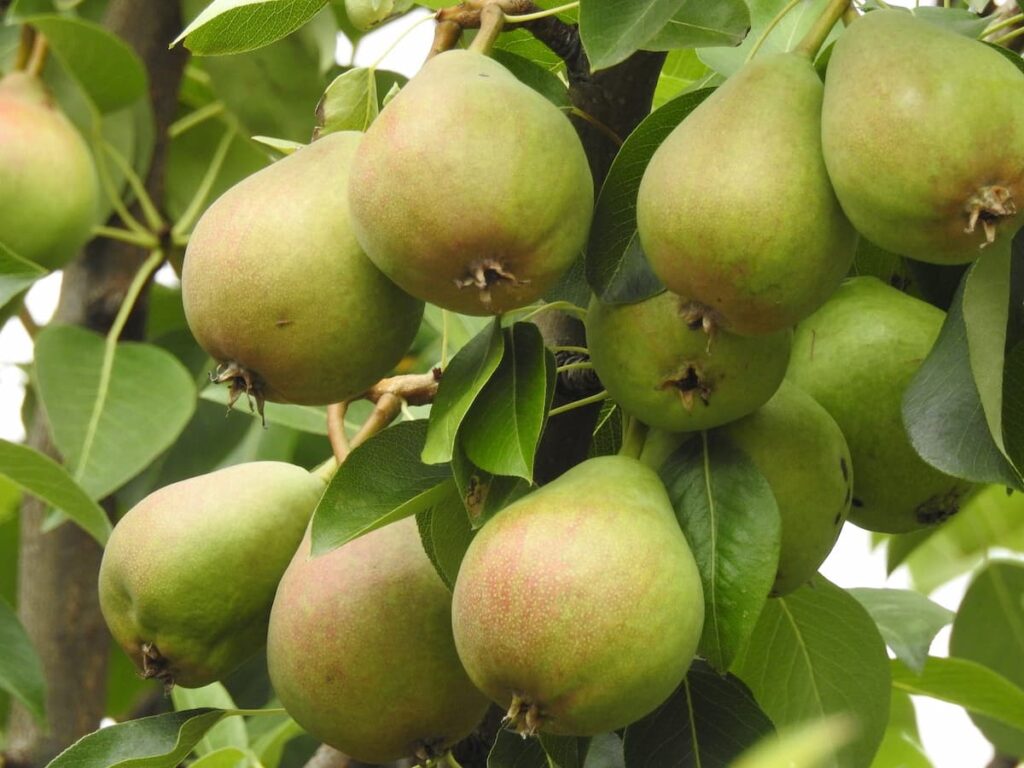
How to grow Pears from seed to harvest
Germinating Pear seeds
- Pears have only a few seeds (maximum 10) but not berries; they belong to a different fruit type. Collect your Pear seeds from ripened Pears that are in your hand. Remove as many seeds as you can’t guarantee that every seed will germinate. You should soak your Pear seeds in a bowl of water overnight. Remove any seeds that float on top because they won’t grow. Then, soak your seeds in a one-part bleach and ten-part water solution for ten minutes. Remove your Pear seeds and let them dry on a paper towel.
- You can fill a resealable plastic bag or sandwich bag with moist peat moss. Or you can also use potting soil instead of peat moss. Press the seeds two or three inches deep into your medium, and place four seeds in each bag. You should place it in the refrigerator. Allow the seeds to germinate for up to three months, checking the moss every two weeks to ensure it hasn’t dried.
- If the room temperature exceeds 5° C, you can remove the seeds from the fridge after three months. Then, fill a small container with a potting mix and place each seed half an inch deep near the sides of the container, keeping them evenly spaced. Water the seeds so the soil is moist but not irrigated with water. Too much water can inhibit their growth or cause root rot.
- You should leave the planted Pear seeds in a well-lit place, such as a window with full sunlight, for two to three weeks. Monitor your seeds for two to three weeks to ensure they sprout small cotyledons. After that, your seeds will show true leaves, larger than cotyledons and more like leaves on a Pear tree.
In case you missed it: 16 Common Pear Tree Problems: How to Fix Them, Solutions, and Treatment
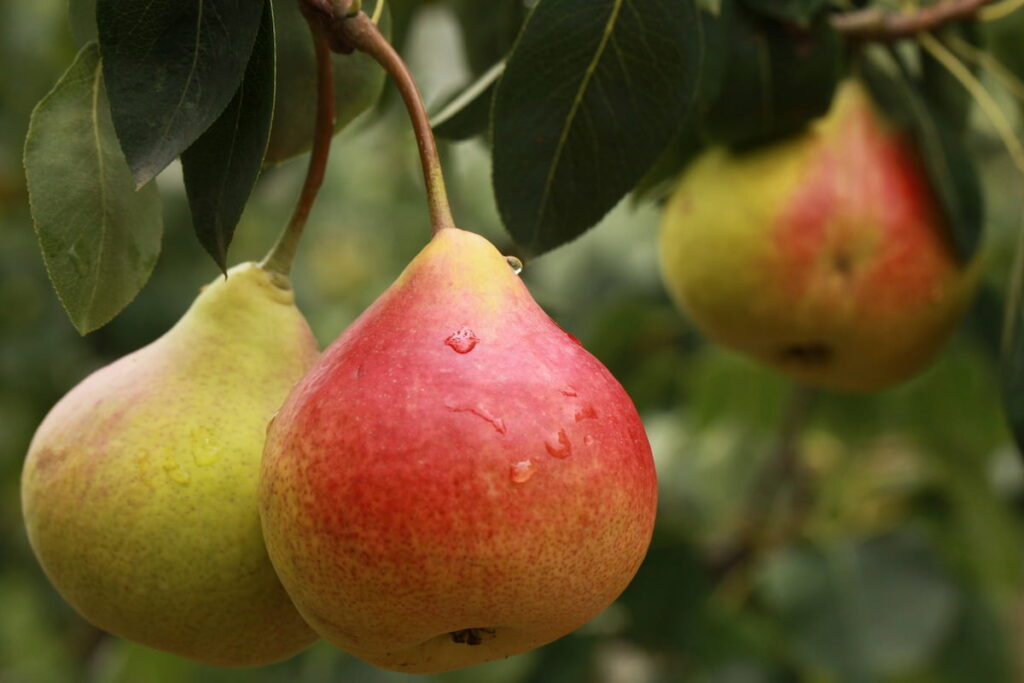
How much time does it take to grow a Pear tree from seed?
- Many people consider Pear trees the easiest fruit tree to grow independently. Asian Pear tree varieties are known as perfect fruit trees for beginners because of how easy they are to care for and how much fruit they produce with a little extra effort.
- While it’s not difficult to grow Pears, most trees produce fruits for three years or more and bear full harvest in five to seven years. Pear trees can live for 75 years and produce heavily. Once the Pear trees are established and begin to produce fruit, you can harvest within three to five months from full bloom.
- For producing most fruit, Pear trees need full sun. Prune the tree yearly to keep it healthy, productive, and looking its best. Trees can take 3 to 10 years to begin flowering and producing fruit. Mature Pear trees are large and produce much fruit in a short window of time.
When can you plant Pear seeds?
Fruit seeds grow best in late winter or early spring. The stratification helps in germination and will produce more seedlings. You can harvest seeds inside a Pear purchased from a grocery store to grow your tree. You should stratify and germinate your Pear seeds indoors before planting them in the ground to increase your chances of growing tall, healthy Pear trees.
Growing pear trees from cuttings
Pear tree propagation is also done through cuttings. You should make a clean cutting at a 45-degree angle 1/4 inch below the leaf node. Put equal portions of vermiculite and perlite into a planter and water. Allow any additional drain before planting Pear cutting.
Water requirement for growing Pear tree
During the first year, it is very important to water your plant. On light/sandy soil, you should give water two times a week, but once a week on clay soil. If the Pear trees receive too much water, they can experience stunted growth, poor fruit production, and death. More water fills the air pockets around the roots, which requires the roots to breathe and properly absorb nutrients. Water your Pear tree regularly until the plant is established. In the first year or so, the tree will only need water in spring and summer.
In case you missed it: Best Fertilizers for Pear Trees: Organic, Homemade, Liquid, Natural, NPK, Compost, How and When to Apply
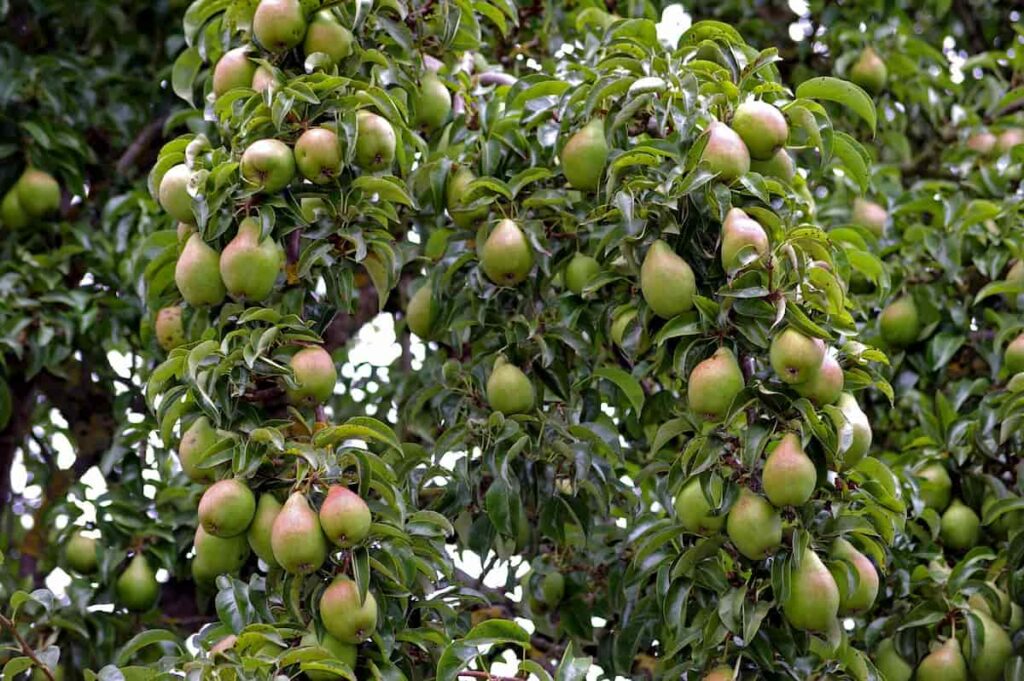
How many Pears grow on a Pear tree?
A well-maintained mature Pear tree will produce up to 70 kg of fruit in a season. However, the tree must be too large for that crop size, making it difficult for a home gardener to harvest the fruit. A dwarf Pear tree produces 22 to 70 kg of fruit per tree.
Do Pear trees need to be pruned?
- You should prune your Pear trees regularly to encourage them to harvest well. Pruning encourages the growth of new fruiting wood and promotes air circulation to keep your tree healthy. It allows enough light through the canopy to help your fruit ripen.
- Cutting your Pear tree yearly helps boost its growth and fruit-bearing ability, protecting it from infection. You will prune in the winter and get rid of the oldest branches of your tree. Thin your tree in a pleasant, effective shape to keep it happy and healthy. You should prune when the tree is young to shape Pear trees. Once it’s about five or six years old, the shape is set in stone, and heavy trimming can be harmful. Remove those broken, dead, or sick branches first.
Fertilizer requirement for growing Pear tree
- When fertilizing a Pear tree, you can use a balanced 13-13-13 fertilizer. Spread 1/2 cup of fertilizer in a circle that is 6 inches. Fertilizing is the best way to replenish nutrients, especially nitrogen, in your soil. Nitrogen encourages the growth of green plants, which is exactly what you want to promote before your Pear tree reaches its fruit-bearing years. Always check your soil before applying any fertilizer.
- Each year, check the soil to see what it needs, and if nitrogen levels appear low, fertilize low amounts of less nitrogen a few weeks before the bud break in early spring. Mulch your trees and keep the weeds at bay, as the weeds will compete with your Pear trees for nutrients.
Growing a Pear tree in a pot
- Whether growing in a small backyard, a terrace without garden space, or a sunny apartment balcony, container-growing Pears are an excellent way to maximize and use every inch of growing potential. Pear trees can be grown in a potted environment.
- The Pear containers should be placed outside in a sunny place that receives at least six hours of light each day. Adequate sunlight and an adequate water supply are essential for the growth of healthy container-growing Pears. Plants in a warm-season climate may need to be watered weekly or even daily to maintain appropriate moisture levels. Finally, care should be taken when fruit trees grow in containers. Selection, pruning, and removing some fruits will benefit the plant, as it can be difficult for trees growing in a container to support and ripen many fruits.
In case you missed it: Pear Gardening For Beginners – How To Start, FAQs
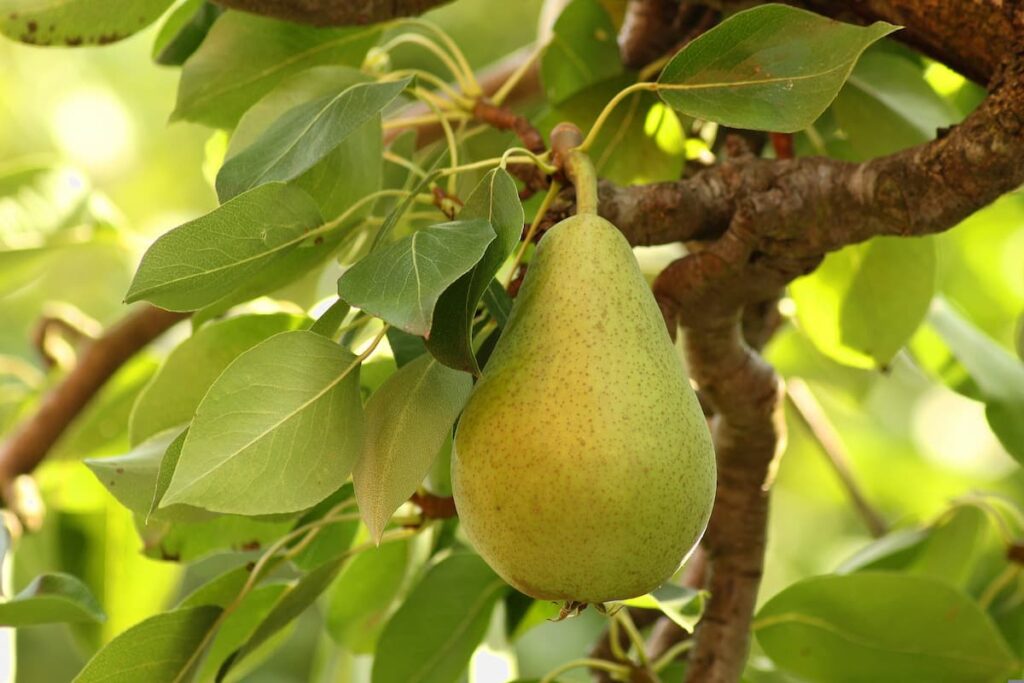
Soil requirement for growing Pear trees
Pear trees thrive well in well-drained sandy loam soils with pH 6.0 to 6.5. However, they can survive in other soils if they are well-drained. They prefer fertile soil rich in organic matter, which retains plenty of moisture in spring and summer. Pear trees make an attractive addition to the home landscape, and they can tolerate wet, heavier soil than most fruit trees. When it comes to soil pH, you probably don’t have to worry too much. Pear trees tolerate a wide enough range to accommodate the soil found in most gardens.
Why is my Pear tree not producing fruit?
If the Pear tree is weak, stressed, or diseased, it will produce very little or poor-quality fruit. If the Pear tree has no fruit, it means the Pear tree didn’t get enough cold weather to break dormancy and encourage new growth. Prune minimally, especially with young trees, as excessive pruning will delay or decrease fruiting and produce too much leafy growth.
Sun requirement for growing Pear trees
Pears require full sunlight. Be sure to choose a place to ensure at least six to eight hours of sunlight to grow a pear tree. Maintenance of the tree will be easier if you plan. Dig a deep hole and mix plenty of fertilizer into the soil. The Pear tree generally thrives in cold and wet climates, where there is winter cold along with a cool summer. Popular Pear varieties require about 400 to 800 cold hours to grow and get fruit.
In case you missed it: Gardening Words: Every Beginner Should Know Before Starting a Garden
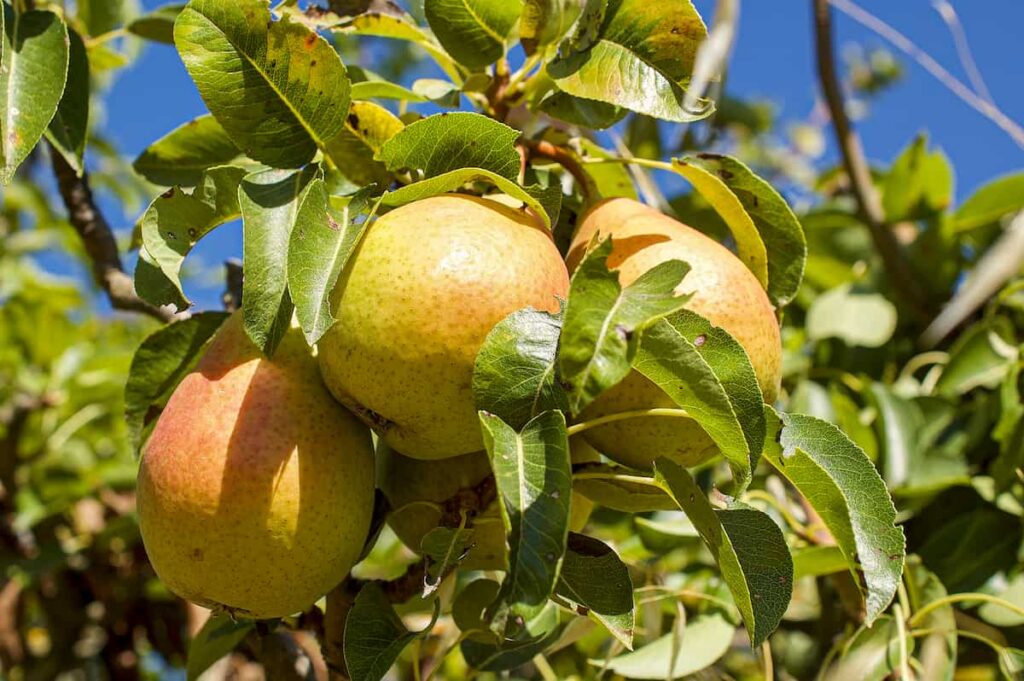
Spacing between Pear trees
- You should space standard-sized trees 20 to 25 feet apart. Space dwarf trees are 12 to 15 feet apart. The root system of the ornamental Pear tree is about 2 feet in the soil and is as wide as its canopy.
- A tree with limited growing space can push through concrete, rock, and other hard surfaces. Bradford Pear trees grow larger at maturity, up to 30 feet in height and 25 feet in width. Young feeder roots reach the edge of the canopy. This means that the surface roots can be up to 50 feet wide.
- You should plant wall-trained trees at least 8 inches from the wall to allow radial growth of the stem. Dig the planting hole about 8 to 6 inches from the wall to reduce root problems.
What month do you pick Pears?
Harvesting of mature summer varieties is expected to begin in August or September. Pear trees start producing fruit three to seven years after planting. Fruits are ready for harvest between summer and mid-autumn, depending on the species and cultivar. Pears are usually available from August to October so you can expect fruit in your garden around autumn. Pears generally require less care than Apples while still producing similar fruits. However, you may have to wait a few years before harvesting anything.
How do I know when Pears are ready to pick?
- The best way to tell if the Pears are ready for harvesting is to tilt the fruit horizontally with it in your hand. Mature fruit will easily come off the branch at this angle. If it’s not ready to pick up, it’ll hold on to the branch.
- Harvest the Pears before they are fully ripened. They should be strong and swollen, with a subtle color change in their skin. Check the early varieties by tasting one of the fruits for sweetness yet firmness. Unlike fruits from many other trees, Pears ripen after picking and not on the branch. Pears have a narrow ripening phase, so storing them in a cool, dry place is best.
In case you missed it: How to Get Rid of Bugs on Indoor Plants: Simple Tips, Ideas, and Techniques

Do Pear trees need another Pear tree?
- As with most fruit trees, you need another variety of their type to get this sweet fruit, and Pear trees are no exception. Although there are self-pollinated Pear trees, you’ll get a better yield with a partner plant.
- Plant at least two Pear trees to ensure cross-pollination and fruit production. Trees should be kept at 15 to 20 feet when planting. Finally, make sure the types you choose are compatible with each other. Starting with just one tree won’t work. For a good crop, Pears require two different varieties for cross-pollination.
Conclusion
Even though Pear trees do not grow true to type from seeds, it is still possible and beneficial to grow a tree from Pear seed. Seedlings are also used as rootstock for potentially desirable varieties. Generally, you should extract, produce, and sow Pear seeds far more than your desired number of trees. Even with proper preparation and maintenance, it is highly unlikely that all seeds will grow. Growing a Pear tree from seed is possible, not difficult, and can be very beneficial if you have patience because the fruit tree takes time and care to bloom.
- How to Grow Tomatoes Organically at Home: A Comprehensive Guide
- Organic Gardening on a Budget: Low-Cost Methods and Materials
- Gongura Seed Germination and Planting Methods
- Cabbage Seed Germination and Selection
- Broccoli Seed Germination and Selection
- Asparagus Seed Germination and Variety Selection
- Seasonal Flower Gardening: Best Practices for Spring, Summer, Fall, and Winter
- How to Grow Hibiscus from Flower
- Plantation Ideas for Home Decoration: A Beginners Guide
- Flower Garden Designs and Layouts for Beginners
- Planting and Spacing Techniques in Papaya: A Beginner’s Guide
- Growing Gold: Essential Techniques for Planting Pineapples
- How to Make Kalanchoe Plant Bushy: Home Remedies and Solutions
- 11 Reasons Why Your Gardenia is Not Blooming: Home Remedies and Solutions
- Eco Elegance: The Guide to Designing a Drought-Tolerant Landscape
- Gardening on a Slope: Strategies for Hillside Landscaping
- Nourish and Flourish: Top Organic Mulches for Thriving House Plants
- Everything You Want to Know about Indian Mogra Flower: Discover Uses and Growing
- Green Thumb Success: Expert Tips for Cultivating Greenhouse Pumpkins All Year Round
- Maximize Growth & Flavor: The Ultimate Guide to Companion Planting in Herb Gardens
- How to Control Rhododendron Problems Naturally: Home Remedies and Organic Ways to Fix Them
- Natural Magic: The Remarkable Benefits of Cinnamon for Plants
- Best Steps to Revive Dying Tulip with Natural and Organic Treatment
- 10 Reasons Why Your Angel Trumpet is Not Blooming: Remedies and Treatment
- How to Fix Periwinkle Leaf and Flower-Related Problems: Natural Remedies and Solutions
- How to Fix Zinnias Leaf and Flower Problems: Discover Natural and Home Remedies
- Organic Steps to Induce Lemon Tree Flowers: A Comprehensive Guide
- Bloom Booster: Crafting the Perfect Homemade Bougainvillea Fertilizer
- Optimizing Growth: A Guide to Applying NPK Fertilizer for Potted Plants
- 10 Best Homemade Fertilizers for Rubber Plant: DIY Recipes and Application Method
- How to Boost Female Pumpkin Flowers: Effective Steps for More Flowers and High Yields
- Transform Your Indoor Garden: Top Benefits of Pink Salt for Houseplants
- 10 Best Homemade Fertilizers for Peacock Plants (Calathea): Easy DIY Guide
- Unlock Blooms: 9 Reasons Why Your Potted Chrysanthemum is Not Blooming
- 8 Reasons Why Your Potted Hibiscus is Not Blooming: Fix it with Simple Solutions
- Unlock Blooms: 9 Key Reasons Your Potted Frangipani Won’t Flower